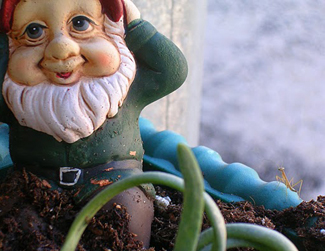| Sun | Mon | Tue | Wed | Thu | Fri | Sat |
|---|---|---|---|---|---|---|
| 1 | 2 | 3 | 4 | 5 | ||
| 6 | 7 | 8 | 9 | 10 | 11 | 12 |
| 13 | 14 | 15 | 16 | 17 | 18 | 19 |
| 20 | 21 | 22 | 23 | 24 | 25 | 26 |
| 27 | 28 | 29 | 30 | 31 |
CATEGORIES
RECENT ENTRIES
BLOG ROLL
Bizarre-ketplace 4: Gut loaded
If garden pests are bugging you, Elise Covic, PhD'10, has just the solution.
 At the end of the academic year, UChicago Marketplace is infused with a sense of panic as graduating students seek to unload furniture, clothing, books, and random items like molecular model kits. “Price is negotiable!!” read one listing for a $200 dining table. “$50 OFF IF YOU PICK IT UP BY THURSDAY!”
At the end of the academic year, UChicago Marketplace is infused with a sense of panic as graduating students seek to unload furniture, clothing, books, and random items like molecular model kits. “Price is negotiable!!” read one listing for a $200 dining table. “$50 OFF IF YOU PICK IT UP BY THURSDAY!”
Against this backdrop of crazed possession-dumping, Elise Covic’s listing, “Pet Praying Mantids/Natural Pesticide” stood out even more than it might have ordinarily. The listing included a large color photo, assurance that releasing mantids to the wild was legal and environmentally sound, and detailed instructions for pet care: “Make sure the prey has been gut loaded (feed a vitamin-enriched food to the prey, which will be passed on to the mantis).”
Covic, PhD’10, a researcher in Murray Sherman’s neurobiology lab, had this to say about her unusual hobby and her failed attempts to make money at it.
How did you get into raising mantids?
A few summers ago I was tutoring this kid in second-grade math. One day he showed me his mantid enclosure and all these little baby mantids. I thought they were the coolest little creatures—so cool that I couldn’t pay attention to tutor him that day. I went home and bought a couple of pods online that night.
Where do you buy mantid pods?
You can get them quite easily, actually. A lot of organic garden supply companies sell them as beneficial insects/natural pesticide. I have a balcony garden, and there were all these aphids and annoying little bugs eating my basil. But I didn’t want to put any pesticide down in case I needed to use my ovaries one day.
What does your boyfriend think about all the mantids in your apartment?
He thinks it’s cool, up to a certain extent. He’s working on his dissertation right now, on economic crises. This year, when the first pod hatched, I stormed in there screaming. He gets kind of annoyed that I’m always trying to stop him to come look at the bugs. My old roommate and I used to like to sit on the back porch, drinking beer and watching the mantids hunt. We could do that for hours.
Is this the first year you tried to sell the hatchlings on Marketplace?
Yes. In a 24-hour period, I had two pods hatch. I was incredibly poor, because I’m a new graduate—but I’m a terrible businesswoman. I pretty much gave them away to anyone who seemed interested. I sold, I think, a group of five mantids for $10. I gave away at least 50, mostly to undergrads who wanted them for pets.
Did your pods this year come from mantids you raised?
No. I release so many outside every year, and I keep looking for their pods, but I can’t find any. They’re $12 for five pods, so it’s easier just to buy them. Last year I tried breeding them, but that didn’t exactly work out. If they did anything, I didn’t catch it. Maybe I needed some Barry White music.
Anything else you want to say about mantids?
We have lab mantids every year. We name each mantis after a neuroscientist. Last year’s mantis was Eric Kandel. Our Chinese mantis this year was Mu-Ming Poo. And the European one is Bert Sakmann. You have to keep them as separate as possible or they’ll start to eat each other.
Carrie Golus, AB’91, AM’93
June 18, 2010
